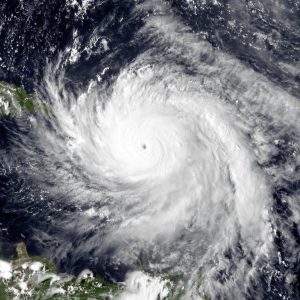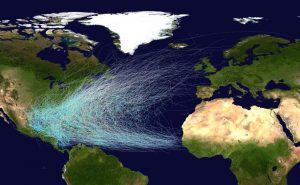7 May 2018
Powerful hurricanes strengthen faster now than 30 years ago
Posted by Lauren Lipuma

A satellite image of Hurricane Maria near peak intensity, moving north towards Puerto Rico, taken on September 19, 2017. Maria underwent explosive intensification, strengthening from a tropical storm to a Category 5 hurricane in just two days.
Credit: U.S. Naval Research Laboratory/NOAA.
Storms intensify more rapidly today due largely to a natural climate phenomenon
By Tom Rickey
Hurricanes that intensify rapidly – a characteristic of almost all powerful hurricanes – do so more strongly and quickly now than they did 30 years ago, according to a new study published in Geophysical Research Letters, a journal of the American Geophysical Union.
Many factors are at play, but the chief driver of more rapid hurricane intensification is a natural climate cycle known as the Atlantic Multidecadal Oscillation (AMO) that affects water temperatures in the Atlantic Ocean where hurricanes form, according to the study’s authors.
The warmer the ocean water, the more powerful a hurricane can become. Since the late 1990s, the AMO has created warmer waters in the central and eastern Atlantic Ocean, according to the study. That’s exactly the alley where hurricanes Irma, Jose and Maria powered up rapidly last year.
“This was a surprise, that the AMO seems to be a bigger influence in rapid intensification than other factors, including overall warming,” said Karthik Balaguru, an atmospheric scientist at the U.S. Department of Energy’s Pacific Northwest National Laboratory in Richland, Washington and lead author of the new study.
Last year’s lineup of powerful storms – Harvey, Irma, Jose and Maria – spurred the authors to take a closer look at the rapid intensification process. This occurs when the maximum wind speed in a hurricane goes up by at least 25 knots (28.8 miles per hour) within a 24-hour period. It’s a rite of passage for nearly all major hurricanes, including the big four of 2017.
In the new study, the researchers analyzed 30 years’ worth of satellite hurricane data encompassing 1986 through 2015. Information came from NOAA’s National Hurricane Center and the U.S. Navy’s Joint Typhoon Warning Center.
They found rapid intensification is not happening more often, but hurricanes that undergo rapid intensification do so more quickly and get stronger. Results show the average boost in wind speed during a 24-hour intensification event is about 11 knots (13 miles per hour) more than it was 30 years ago.

This map shows the tracks of all Atlantic Ocean hurricanes that formed between 1851 and 2012. Hurricanes often rapidly intensify in the western Atlantic and Caribbean Sea, but the new study shows warmer waters in the eastern and central Atlantic over the past several decades have made hurricanes strengthen more quickly before they move west.
Credit: Nilfanion, public domain.
The researchers compared the hurricane data to data on several ocean climate cycles like the AMO and El-Niño-Southern Oscillation (ENSO). They entered the data into various climate models to tease out the impact of global warming on the rapid intensification process.
They found the biggest factor explaining the increasingly rapid intensification is the AMO. The AMO governs how the temperature of the waters in the North Atlantic cycles between warmer and cooler, with each period typically lasting a decade or more. The cycling occurs for reasons scientists don’t completely understand, but it has broad effects on the ocean and environment. The AMO has generally been “positive” – causing warmer waters – since the late 1990s.
Rapid intensification has historically occurred more often in the western Atlantic, but that’s not where the team found the increasing strength of the last 30 years, Balaguru said. Rather, the rapid intensification is happening more in the central and eastern Atlantic, especially to the east of the islands of the Lesser Antilles, which includes the Virgin Islands and Saint Kitts. That’s the same area where the AMO creates warmer waters and boosts ocean heat content.
Teasing out the effects of the AMO from broader effects of global warming was beyond the scope of the current study but is a focus for scientists, Balaguru said.
— Tom Rickey is a Senior Advisor for News and Media Relations at Pacific Northwest National Laboratory. This post originally appeared as a press release on the PNNL website.










 GeoSpace is a blog on Earth and space science, managed by AGU’s Public Information staff. The blog features posts by AGU writers and guest contributors on all sorts of relevant science topics, but with a focus on new research and geo and space sciences-related stories that are currently in the news.
GeoSpace is a blog on Earth and space science, managed by AGU’s Public Information staff. The blog features posts by AGU writers and guest contributors on all sorts of relevant science topics, but with a focus on new research and geo and space sciences-related stories that are currently in the news.
The role of the “AMO” vs anthropogenic forcings in driving the recent warming of SSTs is hotly debated. In this context, the leap this story takes in assigning responsibility for the recent acceleration of hurricane intensification on “natural climate phenomena” is completely unjustified.
Worse the article contradicts itself on this very point. The last sentence says: “Teasing out the effects of the AMO from broader effects of global warming was beyond the scope of the current study.”
The finding that hurricanes are intensifying more rapidly is not new, but this is a welcome confirmation.
What’s not welcome is the commitment of a classic type two error – assigning responsibility to natural factors simply because you cannot “tease out” the impact of global warming.
Please see the recent report by the National Academy of Sciences “Attribution of Extreme Weather Events in the Context of Climate Change,” that categorically rejects this approach as inappropriate.
Here is work demonstrating that the “AMO” as defined in this & related studies suffers from a statistical artifact:
http://science.sciencemag.org/content/347/6225/988.long
https://agupubs.onlinelibrary.wiley.com/doi/abs/10.1002/2014GL059233
https://agupubs.onlinelibrary.wiley.com/doi/full/10.1029/2006EO240001
Again, in this context, the leap this story and study takes in assigning responsibility for the recent acceleration of hurricane intensification on “natural climate phenomena” is completely unjustified.